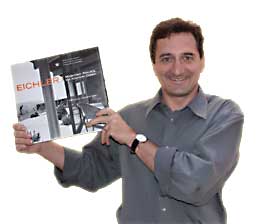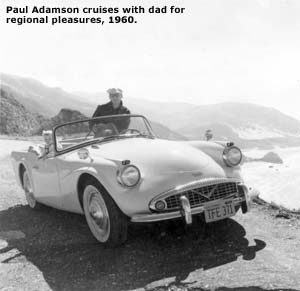Eichler Inspiration: Paul Adamson
 For most of the past decade, I have been consumed by a fascination with the Eichler homes. I first wrote about them in 1984, when I was a graduate student of architecture at Columbia University. I argued then that California's Eichlers qualified as a modern vernacular: modern by social intent and aesthetic expression, and vernacular by their use of local materials and methods and their accommodation of regional traditions.
For most of the past decade, I have been consumed by a fascination with the Eichler homes. I first wrote about them in 1984, when I was a graduate student of architecture at Columbia University. I argued then that California's Eichlers qualified as a modern vernacular: modern by social intent and aesthetic expression, and vernacular by their use of local materials and methods and their accommodation of regional traditions.
Ten years later, after returning to the Bay Area, I was invited to speak at a seminar in Seattle for the American Institute of Architects. There, I presented a paper on the Eichlers, suggesting that this special group of homes had valuable lessons to teach modern designers. The reception I received at that talk was astonishingly enthusiastic. Several curious attendees even asked if there was a book available on the subject.
That experience convinced me to get into to some serious research. Soon afterward I met Eichler Network publisher Marty Arbunich, and we began to collaborate on a series of newsletter articles, each intended as a piece of what we hoped could be a comprehensive study of Joe Eichler's extraordinary legacy of affordable modern housing.
But my motivation for writing 'Eichler: Modernism Rebuilds the American Dream' actually began to form long before my days at Columbia, while I was a child growing up in the Bay Area. I consider myself a product of the 'American Dream.' My parents came to the United States from England on an extended visit in the mid-1950s. It was easy for Britons to obtain green card status during the early postwar, and as many English people did during that time, my father and mother came to America to travel, work, and generally escape the gloom of postwar Europe. My parents were friends from neighboring districts in London, and they traveled together across Canada and down the West Coast to the San Francisco Bay Area, where they worked, my mother in an architectural office and my father as an estimator for a contracting firm.
In 1957, having stayed a year longer than they originally planned, they returned to London and were married, but immediately returned to California. My father was convinced that he could build a career in California. Had he stayed in London, he felt his professional life would have consisted of, as he put it, "waiting to fill dead men's shoes." In San Francisco, he became successful, and his faith that the newness of California would support his dreams of a better life never wavered.
I remember my parents enthusing about the ambient pleasures of the region—the clear, bright sunlight, warm temperatures, and the abundant natural landscape. We vacationed in the deserts, Death Valley and Palm Springs, because there was nothing like that in England, and indulged in outdoor hobbies. We also enjoyed our houses, first a tiny two-bedroom hillside house in Marin County, then a stretched-out, ranch-style home in the hills of Orinda, and finally a remodeled 1920s craftsman bungalow in Los Altos. Each one enabled the indoor-outdoor living made famous by shelter magazines of the postwar period.
 Regardless of their personal satisfaction with their homes, however, my parents embraced 'house hunting,' as did many people we knew, as a weekend recreation. Driving around the suburban neighborhoods of the Bay Area, we saw the eclectic variety of homes for sale. Occasionally our drives would be punctuated with a sighting of a house that offered distinctive qualities, and sometimes my mother or father would call out, "There's an Eichler!" To them the Eichler homes epitomized California living. More than that, however, the houses built by Joe Eichler stood out from their surroundings because they were well designed, not beholden to a preconceived image, and yet marked by a consistency, purity, and elegance almost unique amid the bland predictability of ever-spreading middle-class tracts.
Regardless of their personal satisfaction with their homes, however, my parents embraced 'house hunting,' as did many people we knew, as a weekend recreation. Driving around the suburban neighborhoods of the Bay Area, we saw the eclectic variety of homes for sale. Occasionally our drives would be punctuated with a sighting of a house that offered distinctive qualities, and sometimes my mother or father would call out, "There's an Eichler!" To them the Eichler homes epitomized California living. More than that, however, the houses built by Joe Eichler stood out from their surroundings because they were well designed, not beholden to a preconceived image, and yet marked by a consistency, purity, and elegance almost unique amid the bland predictability of ever-spreading middle-class tracts.




